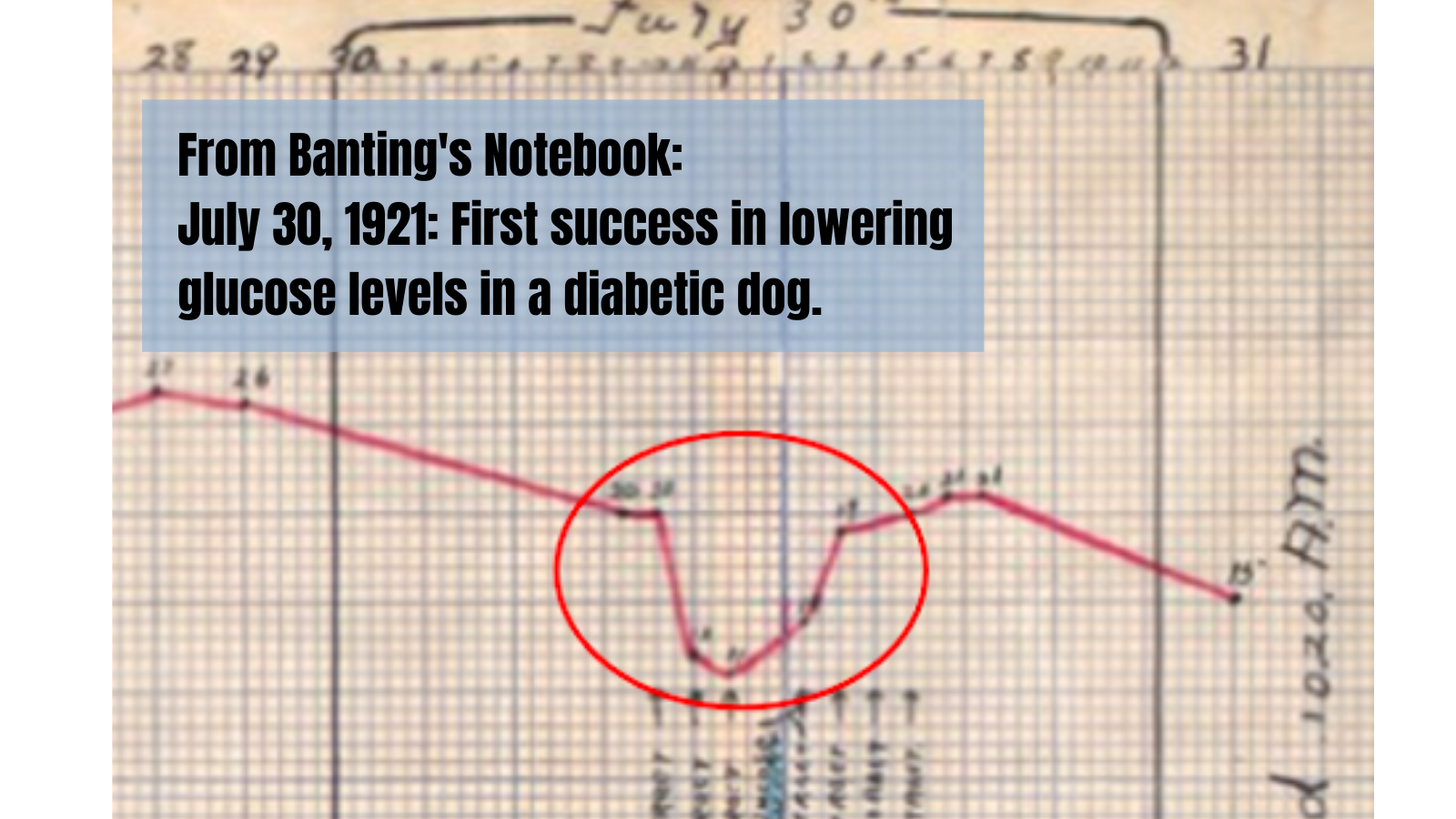Main Second Level Navigation
Insulin100: Celebrate the Day of Discovery!

It was a hot day in the lab in the Department of Physiology, July 30th, 1921, when — after a rocky start and a steep learning curve — Charles Best and Dr. Frederick Banting, under the direction of Dr. John Macleod, had their first success in using insulin (as it came to be known) to lower blood sugar in a diabetic dog. A true eureka moment!
Ever since, The Department of Physiology has built on the legacy of that day of discovery. In honour of that watershed moment 100 years ago, we celebrate our ongoing contributions toward a diabetes-free future. Please enjoy a selection of highlights of our Department's internationally recognized diabetes research, as well as our contributions to the ongoing celebration of 100 years of insulin happening throughout 2021, both here at U of T and all around the world. Here's to the next 100 years of innovations, collaborations, and eureka moments.
| [[{"fid":"12472","view_mode":"default","fields":{"format":"default"},"link_text":"Dr. Patricia Brubaker on The History of Insulin","type":"media","field_deltas":{"1":{"format":"default"}},"attributes":{"class":"media-element file-default","data-delta":"1"}}]] | Dr. Patricia Brubaker Presents on History of Insulin at Vanderbilt UniversityHired by the late Dr. Mladen Vranic, who was hired by Dr. Charles Best, Dr. Brubaker considers herself two degrees of separation away from the insulin discovery team. As someone who lives with diabetes herself, Brubaker is especially compelled and inspired by our department’s legacy. As such, not only is she a Lifetime Achievement Award-winning diabetes researcher with plenty of eureka moments of her own under her belt, she's also Physiology’s resident insulin historian. In May, she presented a lecture on the history of insulin for Vanderbilt’s William D. Salmon lectureship. Drawing on The Discovery of Insulin, the late Michael Bliss’s groundbreaking book, Dr. Brubaker gives us a comprehensive picture of what went into this world-changing moment, grounding us in the science that had gone before, as well as the leadership and collaborations that made this discovery possible. Check out the 25-minute mark when Dr. Brubaker details the day of discovery, complete with archival images indicating that historical first blood sugar drop. Want more history?Dr. Brubaker also collaborated with Dr. Gary Lewis on “The discovery of insulin revisited: lessons for the modern era” for the Journal of Clinical Investigation. |
Drs. Adria Giacca, Gary Lewis, and Team Contribute Review to Special Insulin Issue of Cell Metabolism on Hepatic Glucose ProductionDrs. Giacca and Lewis were invited to contribute a perspective on “Direct and indirect control of hepatic glucose production by insulin” for a special issue of Cell Metabolism celebrating 100 years of insulin, along with additional co-authors who have done recent work on the subject. Giacca and Lewis explained that one of the most important things insulin does is to act as a highly regulated brake on the production of glucose by the liver. Typically, the pancreas drains insulin into a big vein called the portal vein, it’s “filtered” there and about half goes out via the general circulation to the rest of the body. They explained that there has been significant debate about whether direct or indirect action is more important, and under what conditions. Highlighting this physiology continues to be of vital importance to clinical applications. “Elucidating what’s going on physiologically could have an important effect on treatments,” Giacca said. Learn more:Click here to read more from our illuminating interview with Drs. Giacca and Lewis, and click here to read the review. The insulin issue of Cell Metabolism also includes work by the Nostro Lab and a heartfelt editorial introduction by Physiology's Tony K. Lam who helped bring together this special issue. | [[{"fid":"12481","view_mode":"default","fields":{"format":"default","field_file_image_alt_text[und][0][value]":"Photo of Drs. Adria Giacca and Gary Lewis with Cell Metabolism Logo","field_file_image_title_text[und][0][value]":false},"link_text":null,"type":"media","field_deltas":{"9":{"format":"default","field_file_image_alt_text[und][0][value]":"Photo of Drs. Adria Giacca and Gary Lewis with Cell Metabolism Logo","field_file_image_title_text[und][0][value]":false}},"attributes":{"alt":"Photo of Drs. Adria Giacca and Gary Lewis with Cell Metabolism Logo","class":"media-element file-default","data-delta":"9"}}]] |
| [[{"fid":"12474","view_mode":"default","fields":{"format":"default"},"link_text":"Emily McGaugh from Department of Physiology","type":"media","field_deltas":{"2":{"format":"default"}},"attributes":{"class":"media-element file-default","data-delta":"2"}}]] | PhD Candidate Emily McGaugh Won the People's Choice Award for her 3MT on Pluripotent Stem Cell ResearchThe 3MT competition is open to all graduate students enrolled in Canadian universities with competitions held at the local, provincial, and national levels. Participants have three minutes or less to present their research to a panel of non-specialist judges. The challenge is to present complex research information in an engaging, accessible, and compelling way. In three minutes, McGaugh was able to explain the work she does in her lab toward creating beta-like cells from pluripotent stem cells — cells that have the ability to undergo self-renewal and give rise to all cells of the tissues of the body. Using the analogy of the process of making a phone call, McGaugh deftly explained how she helps these unique cells “make choices” to become cells that could eventually allow a person with diabetes to create their own insulin. She shared that her sister’s diabetes diagnosis led her down this career path, adding a personal touch to her speech. Check out her presentation and read an interview with McGaugh here. |
The Nostro Lab Released a Pre-print On Sorting Pancreatic Progenitor Cells to Increase Their Safety For TherapiesIn this video, post-doctoral fellow and first author, Dr. Yasaman Aghazadeh, explains the potential of purifying stem cell-derived pancreatic progenitor cells in advance of using them for therapies. Currently, this population contains non-pancreatic cells that may give rise to tumors upon implantation, thus posing a significant health risk to the recipients. In an important 2017 study, the Nostro Lab first identified glycoprotein 2 as a specific cell surface marker of human pancreatic progenitor cells. Aghazadeh, Nostro, and team built on this discovery to purify the pancreatic progenitor population from non-pancreatic cells. Their results indicate that this cell sorting based on marker expression may eliminate the risk of tumors entirely without jeopardizing the beta cells’ capacity to sense glucose and produce insulin. Dr. Nostro was awarded a team grant as part of the CIHR-JDRF Partnership to Defeat Diabetes earlier this year that will accelerate this work. Tune into the video for Aghazadeh’s full details on this exciting discovery-in-progress. | [[{"fid":"12480","view_mode":"default","fields":{"format":"default"},"link_text":"New Pre-Print From the Nostro Lab","type":"media","field_deltas":{"8":{"format":"default"}},"attributes":{"class":"media-element file-default","data-delta":"8"}}]] |
Dr. Brubaker Appeared on Diabetes Canada Podcast to Discuss Her Research on Glucagon-Like Peptides and What Inspires Her WorkAbove, we mentioned that Dr. Brubaker has had some eureka moments of her own. She was recently invited to the Diabetes Canada Podcast to elaborate on her groundbreaking work with the glucagon-like peptides and the conversation is well worth a listen. In the interview with host and writer, Krista Lamb, Brubaker breaks down the function of glucagon-like peptides — hormones produced by our intestinal tracts — and how glucagon-like peptide 1 is involved in current type two diabetes therapies. She highlights her lab’s recent work on the relationship between these hormones and our circadian rhythms and the implications this research might have on future therapies. At around the halfway point of the podcast, Brubaker explains how she became inspired to research these hormones after unexpectedly developing type 1 diabetes during the early stages of her PhD studies. She pays tribute to her late mentor, former Physiology Chair, Dr. Mladen Vranic, who taught her to be a thoughtful, reflective researcher, and — by modeling his love of music, film, and travel — taught her the importance of work/life balance as well. Click here to listen and learn why Brubaker is so often cited as an inspiring mentor herself. | |
Department of Physiology’s Insulin100 Committee Advised Canada Post on Commemorative StampIn 2019, Department Chair, Dr. Scott Heximer, reached out to Canada Post regarding a potential collaboration with no idea of the level of detail that goes into the making of a stamp. Soon the department’s whole Insulin100 Steering Committee (Drs. Patricia Brubaker (Chair), Cristina Nostro, Denise Belsham, Michael Wheeler, and Scott Heximer) were sifting through and deliberating over archival documents and images, several of which they shared with Canada Post. The team was also involved in fact-checking on the project, as were other local experts and historians. Heximer was thrilled with the resulting stamp and packaging as it helps to shed light on the importance of the Department’s history. “[That history] reminds us that we, as leaders in a scientific community, have a responsibility to recognize the possibility of new ideas and, where possible, provide the resources and support necessary to realize them,” he said. Read more about the stamp and Physiology’s contributions here and here. | [[{"fid":"12436","view_mode":"default","fields":{"format":"default","field_file_image_alt_text[und][0][value]":"Photo of the Insulin 100 Commerorative Stamp","field_file_image_title_text[und][0][value]":false},"link_text":null,"type":"media","field_deltas":{"10":{"format":"default","field_file_image_alt_text[und][0][value]":"Photo of the Insulin 100 Commerorative Stamp","field_file_image_title_text[und][0][value]":false}},"attributes":{"alt":"Photo of the Insulin 100 Commerorative Stamp","class":"media-element file-default","data-delta":"10"}}]] |
| [[{"fid":"12482","view_mode":"default","fields":{"format":"default","field_file_image_alt_text[und][0][value]":"Word cloud image made up of names of diabetes researchers who live with diabetes","field_file_image_title_text[und][0][value]":false},"link_text":null,"type":"media","field_deltas":{"11":{"format":"default","field_file_image_alt_text[und][0][value]":"Word cloud image made up of names of diabetes researchers who live with diabetes","field_file_image_title_text[und][0][value]":false}},"attributes":{"alt":"Word cloud image made up of names of diabetes researchers who live with diabetes","class":"media-element file-default","data-delta":"11"}}]] | Researchers Living With Diabetes Were Honoured With Collaborative Wordle ProjectDr. Brubaker collaborated with York University’s Dr. Michael Riddell to produce an image that honours diabetes researchers who live with diabetes themselves. The image contains well over 100 names and continues to grow. Both Brubaker and Riddell continue to get contributions via email and Twitter. When Ridell posted an iteration, the response was huge. “This is awesome!!! I’m going to print it out and hang it on my wall! Love it!” one included researcher tweeted, while a mom to a child with diabetes wrote “There is no one I trust more than a person with #T1D researching #T1D. Thank you all for your dedication... above and beyond the job.” The response to this celebratory project highlights the relevance of lived experience to scientific and clinical study. |

